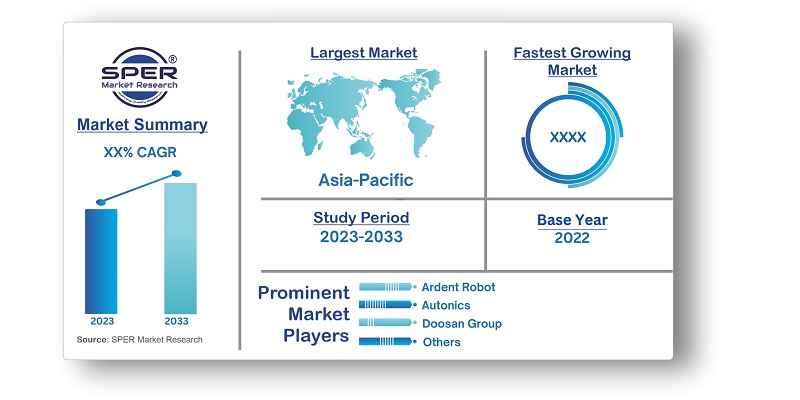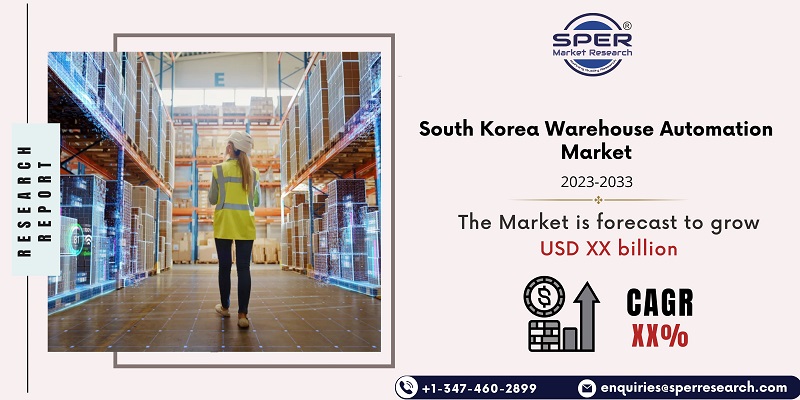
South Korea Warehouse Automation Market Growth, Size, Trends, Revenue and Future Outlook
South Korea Warehouse Automation Market Size- By Robot Type, By System, By Payload Capacity- Regional Outlook, Competitive Strategies and Segment Forecast to 2033
| Published: Dec-2023 | Report ID: IACT23212 | Pages: 1 - 103 | Formats*: |
| Category : Information & Communications Technology | |||
- June 2019: The "Manufacturing Renaissance Vision" program was unveiled by the Korean government in June 2019 with the goal of reviving and improving the manufacturing sector's innovation drive and, in the long run, realigning industries to more value-added strategies.
- 2022: The Korean government invested $1.9 billion on R&D projects in 2022 in order to encourage small and medium-sized enterprises to progress and enhance automated technology. Therefore, the focus of smart factories is mostly on automated manufacturing settings that make use of Industrial Internet of Things (IIoT) sensors for real-time monitoring and artificial intelligence (AI) optimization.


| Report Metric | Details |
| Market size available for years | 2019-2033 |
| Base year considered | 2022 |
| Forecast period | 2023-2033 |
| Segments covered | By Robot Type, By System, By Payload Capacity |
| Regions covered | Seoul metropolitan area, Chungcheong, Jeolla, Gyeongbuk, and Gyeongnam |
| Companies Covered | Ardent Robot, Autonics, Doosan Group, ETRI, GridOne, Hankook, ITS, KORNIC Automation, SeAH Besteel, XAVIS, H.I.T Automative aand various others |
- E-commerce Companies
- Third-Party Logistic Providers
- Potential Market Entrants
- Freight Forwarding Companies
- Warehousing Companies
- Cold Storage Companies
- Industry Associations
- Consulting Agencies
- Government Bodies & Regulating Authorities
| By Robot Type: |
|
| By System: |
|
| By Payload Capacity: |
|
- South Korea Warehouse Automation Market Size (FY’2023-FY’2033)
- Overview of South Korea Warehouse Automation Market
- Segmentation of South Korea Warehouse Automation Market By Robot Type (Articulated Robots, Cartesian Robots, Cylindrical Robots, Mobile Robots, SCARA Robots)
- Segmentation of South Korea Warehouse Automation Market By System (Packaging, Palletizing & De-palletizing, Pick & Place, Transportation)
- Segmentation of South Korea Warehouse Automation Market By Payload Capacity (0.5 Kg - 10 Kg, 11 Kg - 80 Kg, 81 Kg - 180 Kg, 181 - 300 Kg, 301 - 900 Kg, More Than 900 Kg)
- Statistical Snap of South Korea Warehouse Automation Market
- Expansion Analysis of South Korea Warehouse Automation Market
- Problems and Obstacles in South Korea Warehouse Automation Market
- Competitive Landscape in the South Korea Warehouse Automation Market
- Impact of COVID-19 and Demonetization on South Korea Warehouse Automation Market
- Details on Current Investment in South Korea Warehouse Automation Market
- Competitive Analysis of South Korea Warehouse Automation Market
- Prominent Players in the South Korea Warehouse Automation Market
- SWOT Analysis of South Korea Warehouse Automation Market
1.1. Scope of the report1.2. Market segment analysis
2.1. Research data source2.1.1. Secondary Data2.1.2. Primary Data2.1.3. SPER’s internal database2.1.4. Premium insight from KOL’s2.2. Market size estimation2.2.1. Top-down and Bottom-up approach2.3. Data triangulation
4.1. Driver, Restraint, Opportunity and Challenges analysis4.1.1. Drivers4.1.2. Restraints4.1.3. Opportunities4.1.4. Challenges4.2. COVID-19 Impacts of the South Korea Warehouse Automation Market
5.1. SWOT Analysis5.1.1. Strengths5.1.2. Weaknesses5.1.3. Opportunities5.1.4. Threats5.2. PESTEL Analysis5.2.1. Political Landscape5.2.2. Economic Landscape5.2.3. Social Landscape5.2.4. Technological Landscape5.2.5. Environmental Landscape5.2.6. Legal Landscape5.3. PORTER’s Five Forces5.3.1. Bargaining power of suppliers5.3.2. Bargaining power of buyers5.3.3. Threat of Substitute5.3.4. Threat of new entrant5.3.5. Competitive rivalry5.4. Heat Map Analysis
6.1. South Korea Warehouse Automation Market Manufacturing Base Distribution, Sales Area, Product Type6.2. Mergers & Acquisitions, Partnerships, Product Launch, and Collaboration in South Korea Warehouse Automation Market
7.1. South Korea Warehouse Automation Market Value Share and Forecast, By Robot Type, 2023-20337.2. Articulated Robots7.3. Cartesian Robots7.4. Cylindrical Robots7.5. Mobile Robots7.6. SCARA Robots
8.1. South Korea Warehouse Automation Market Value Share and Forecast, By System, 2023-20338.2. Packaging8.3. Palletizing & De-palletizing8.4. Pick & Place8.5. Transportation
9.1. South Korea Warehouse Automation Market Value Share and Forecast, By Payload Capacity, 2023-20339.2. 0.5 Kg - 10 Kg9.3. 11 Kg - 80 Kg9.4. 81 Kg - 180 Kg9.5. 181 - 300 Kg9.6. 301 - 900 Kg9.7. More Than 900 Kg
10.1. South Korea Warehouse Automation Market Size and Market Share
11.1. South Korea Warehouse Automation Market Size and Market Share By Robot Type (2019-2026)11.2. South Korea Warehouse Automation Market Size and Market Share By Robot Type (2027-2033)
12.1. South Korea Warehouse Automation Market Size and Market Share By System (2019-2026)12.2. South Korea Warehouse Automation Market Size and Market Share By System (2027-2033)
13.1. South Korea Warehouse Automation Market Size and Market Share By Payload Capacity (2019-2026)13.2. South Korea Warehouse Automation Market Size and Market Share By Payload Capacity (2027-2033)
14.1. South Korea Warehouse Automation Market Size and Market Share By Region (2019-2026)14.2. South Korea Warehouse Automation Market Size and Market Share By Region (2027-2033)14.3. Chungcheong14.4. Gyeongbuk14.5. Gyeongnam14.6. Jeolla14.7. Seoul metropolitan area
15.1. Ardent Robot15.1.1. Company details15.1.2. Financial outlook15.1.3. Product summary15.1.4. Recent developments15.2. Autonics15.2.1. Company details15.2.2. Financial outlook15.2.3. Product summary15.2.4. Recent developments15.3. Doosan Group15.3.1. Company details15.3.2. Financial outlook15.3.3. Product summary15.3.4. Recent developments15.4. ETRI15.4.1. Company details15.4.2. Financial outlook15.4.3. Product summary15.4.4. Recent developments15.5. GridOne15.5.1. Company details15.5.2. Financial outlook15.5.3. Product summary15.5.4. Recent developments15.6. Hankook15.6.1. Company details15.6.2. Financial outlook15.6.3. Product summary15.6.4. Recent developments15.7. ITS15.7.1. Company details15.7.2. Financial outlook15.7.3. Product summary15.7.4. Recent developments15.8. KORNIC Automation15.8.1. Company details15.8.2. Financial outlook15.8.3. Product summary15.8.4. Recent developments
15.9 SeAH Besteel
15.9.1 Company details15.9.2 Financial outlook15.9.3 Product summary15.9.4 Recent developments15.20 Others
SPER Market Research’s methodology uses great emphasis on primary research to ensure that the market intelligence insights are up to date, reliable and accurate. Primary interviews are done with players involved in each phase of a supply chain to analyze the market forecasting. The secondary research method is used to help you fully understand how the future markets and the spending patterns look likes.
The report is based on in-depth qualitative and quantitative analysis of the Product Market. The quantitative analysis involves the application of various projection and sampling techniques. The qualitative analysis involves primary interviews, surveys, and vendor briefings. The data gathered as a result of these processes are validated through experts opinion. Our research methodology entails an ideal mixture of primary and secondary initiatives.



Frequently Asked Questions About This Report
PLACE AN ORDER
Year End Discount
Sample Report
Pre-Purchase Inquiry
NEED CUSTOMIZATION?
Request CustomizationCALL OR EMAIL US
100% Secure Payment






Related Reports
Our Global Clients
Our data-driven insights have influenced the strategy of 200+ reputed companies across the globe.




















